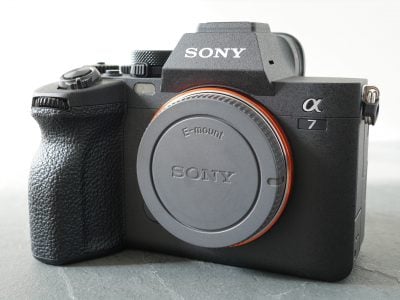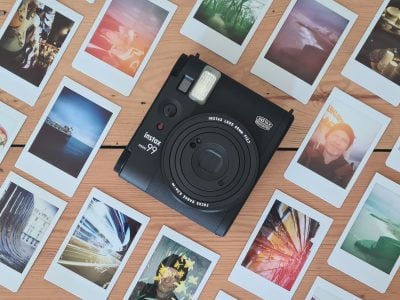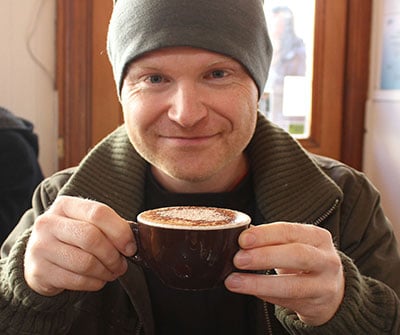Fujifilm GFX100RF review
-
-
Written by Gordon Laing
Intro
The Fujifilm GFX100RF is a fixed lens rangefinder-styled camera with a 102 Megapixel medium format sensor. Announced in March 2025 and available in black or silver finishes, it essentially takes the large sensor, image processor and viewfinder of the GFX100S II and packs them into a smaller and lighter body with a fixed 28mm equivalent lens that’s more akin to a slightly chunkier version of the popular X100 series.
Fujifilm says it’s aimed at high-end enthusiasts and serious pros who appreciate the style of a rangefinder camera. I’d say if you loved the X100 but just wished it had a much larger sensor with way higher resolution photos, this is the camera for you. And while it can film respectable video, this is a camera aimed at photography first; how often do we get to say that?
Find out how it looks, feels and compares physically in my first-looks video below, which includes some initial sample images. I’ve also added lots more sample images throughout this page, and if you also prefer to read the written review, keep scrolling. Also check out my review of the camera during a week long trip to Iceland below!
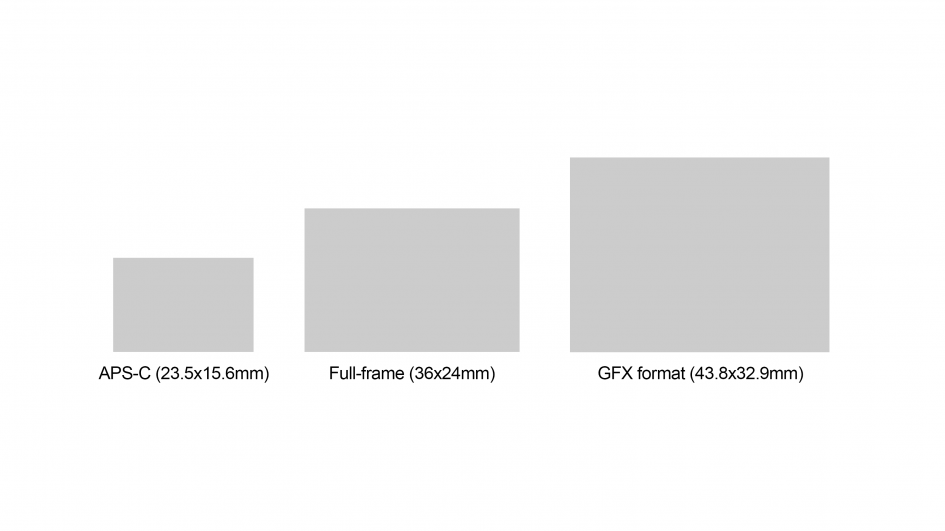
Above: First things first, just how large is the sensor in a GFX body? Here’s a diagram I made to show the relative size between APSC sensors with a 1.5x crop on the left, full-frame in the middle, and GFX on the right. Note the GFX sensor shape is a squarer 4:3 ratio. So while GFX is smaller than any of the film-based medium formats, even 645, it remains larger than full-frame, allowing it to pack-in more pixels without them becoming too small. It’s also approximately four times the area of the APSC sensors used in Fujifilm’s X-series.
Ok, so the first thing I want to share about the GFX100RF is how big it is compared to other cameras. So for my first comparison, here’s the 100RF on the left and the X100 VI on the right, and already it’s clear how the former is essentially a chunkier version of the latter. But how much so?
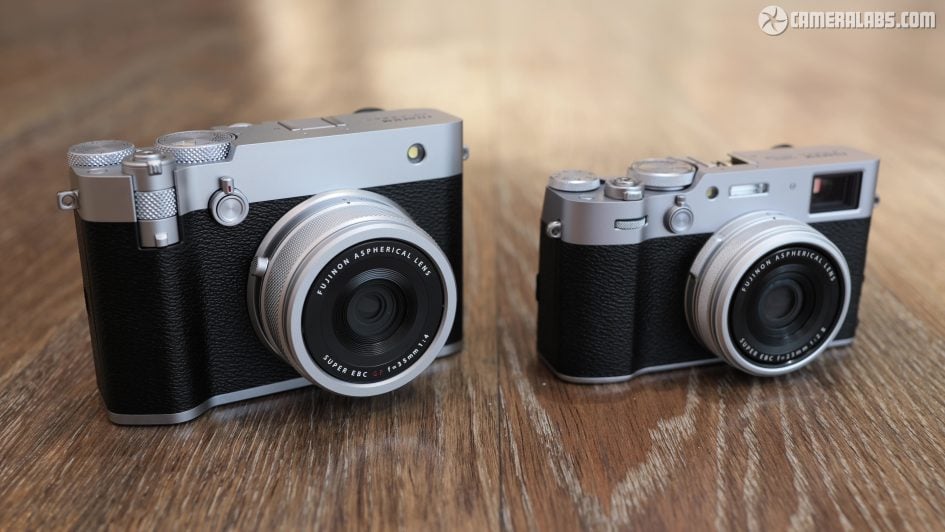
Well considering the considerable difference in sensor size, the 100RF on the left measures an impressively compact 134 wide, 90mm tall and 77mm thick including the lens, with the left side of the body slimming to 37mm. It weighs 735g including battery. In comparison, the X100 VI measures 128mm wide, 75mm tall, and 55mm including the lens, again with the left side slimming down to 33mm. It weighs 521g including battery.
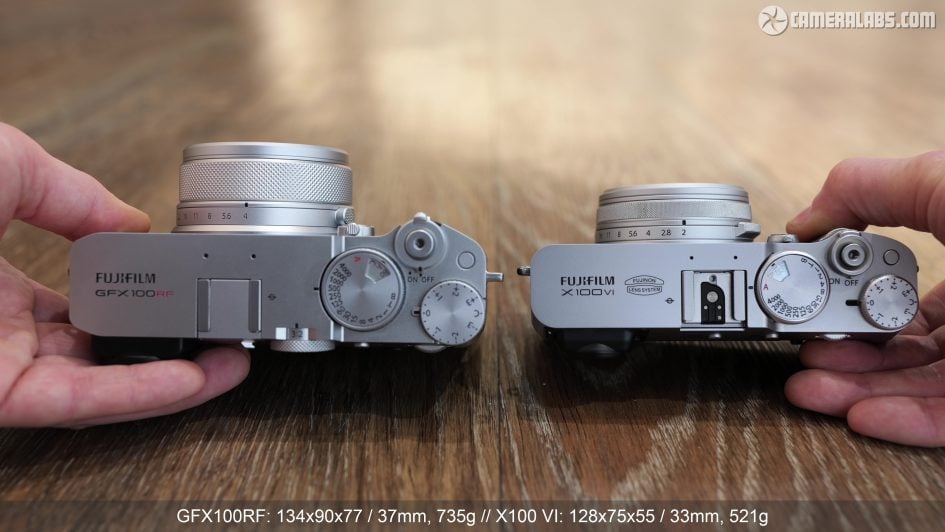
So the 100RF is only 6mm wider, 15mm taller and 20mm thicker when measuring the lens, while the main body is only 4mm thicker. And in terms of weight, the 100RF is just 214g heavier, or around 50% more. In your hands, the 100RF is clearly larger and heavier, but the impressive part is they’re not a World apart. They’re actually similar propositions in use and when carried in a bag or coat pocket.
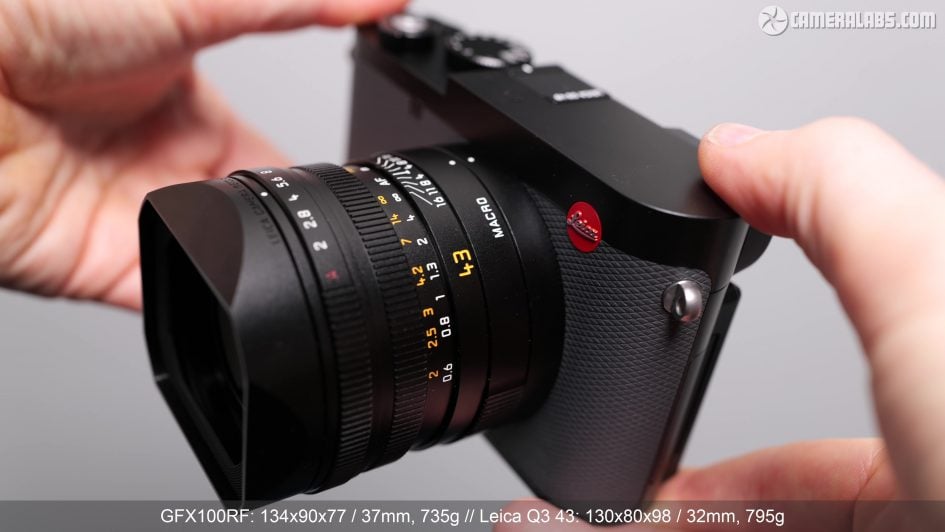
How about the Leica Q3 43, arguably the most desirable fixed lens compact with a full-frame sensor? At 130x80x98mm, slimming to 32mm at the thinnest point and weighing 795g, it’s not quite as wide or tall as the 100RF, but the lens protrudes a noticeable 21mm longer making it more awkward to accommodate in a small bag or pocket, and it’s 60g heavier too. To be fair the Leica lens has a longer focal length, a brighter f2 aperture and optical stabilisation too, but the GFX100RF counters with a larger and more detailed sensor, and a price tag that’s over a grand cheaper.
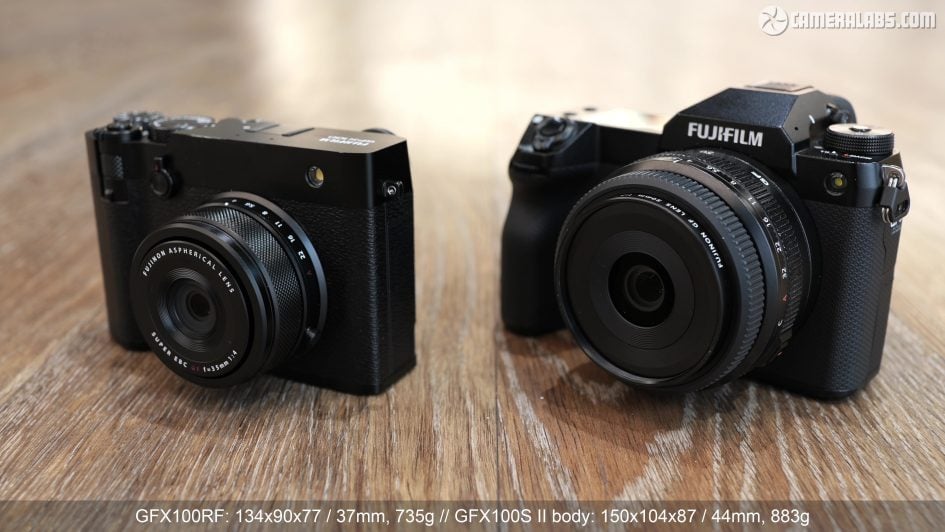
How about versus the smallest GFX body with interchangeable lenses in the current lineup? That’ll be the GFX100S II, here on the right, while I’ve popped the black version of the 100RF on the left. The GFX100S II body is chunkier all-round at 150x104x87mm, slimming to 44mm at the thinnest point, and heavier too at 883g. And remember that’s without a lens.
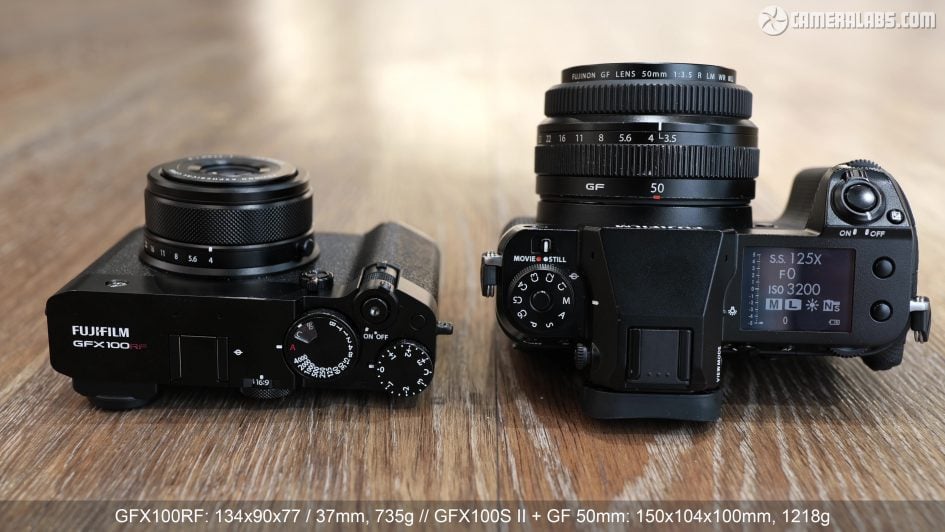
Add the most compact GF lens in the current lineup, the 50mm f3.5 and it becomes 48mm thicker and 335g heavier. Plus that’s not even a matching focal length. So now here’s the GFX100S II fitted with the closest focal length to the 100RF, using the GF 30mm f3.5 where it’s clearly a completely different class.
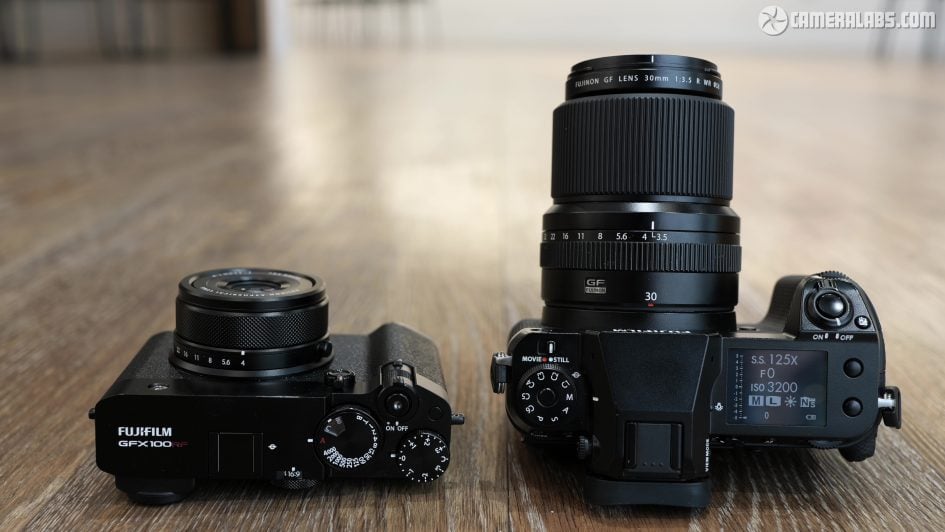
Of course all of this so far conveniently forgets there was a shorter rangefinder camera in the GFX series, the 50R from 2018.
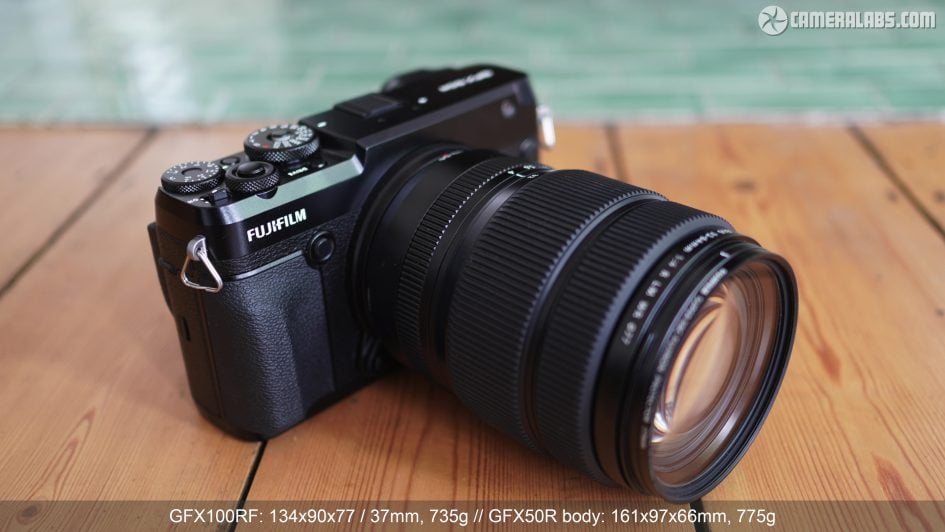
At 161x97x66mm and 775g, it was wider than the GFX100S II, but shorter, thinner and over 100g lighter, but that still made it bigger and heavier than the 100RF and remember for the body alone without a lens.
Bottom line, the GFX100RF is impressively small for a camera with a medium format sensor, and physically comparable to some full-frame alternatives. Meanwhile most X100 owners won’t feel it’s deal-breakingly heftier.
Moving onto design and build quality, the GFX100RF is similar to the X100. The top plate is milled from a single block of aluminium. The body is mostly weatherproof, although like the X100, the mild lens extension during power-up and focusing prevents it from being sealed out of the box.
So like the X100 series, you’ll need to remove a ring from the lens housing, screw-in the filter adapter, then mount a 49mm protective filter for full sealing. Unlike the X100 series though, Fujifilm includes all these accessories in the box, as well as a smart-looking rectangular lens hood with its own sliding cap. And like all GFX bodies to date, the 100RF is also made in Japan.
In terms of controls, the 100RF at first glance looks a lot like the X100 series, with a dedicated shutter dial which can be lifted-up to adjust the sensitivity, a threaded shutter release inside a power collar, and a dedicated exposure compensation dial.
But there’s a few key changes. First starting on the front, note the new barrel design continuing down from the shutter and power control. The textured segment in the middle is the front finger dial, a departure from other Fujifilm bodies and not clickable. It looks nice, but in my initial tests I found it a little flush with the barrel and not as easy or positive to turn as I’d like.
Below this is a new spring-loaded lever control which can be pushed left or right, before snapping back to the middle. This operates a digital teleconverter, cycling between the native 28mm equivalent, and cropped 35, 50 and 63mm equivalents. This currently only works for photo and has no function for video, but I’ve requested they add similar crops for video as it would match the photo experience while also maintaining 4k detail.
Of course for photos though, the crops will result in lower resolutions, and Fujifilm isn’t doing any interpolation. So you start with the full 102 Megapixels, then crop-down to 66, 31 and 20 Megapixels respectively. But you do get to see the field-reduction of the crop when composing which can be useful.
Note the actual live view video feed you compose and focus with is a fixed resolution though, so you may notice a mild drop in viewfinder detail as you employ the digital teleconverter to zoom-in. Also note this control is not customisable, but since it’s not physically labelled, I hope Fujifilm will unlock it for customisation in the future. Also note the twisting lever to the right of the barrel section, styled like a self-timer crank on a film camera and used on the X100 series to adjust the viewfinder mode. As I’ll explain in a moment, the 100RF’s viewfinder is electronic-only, so this control can be customised for other functions, and by default adjusts the viewing modes.
Round the back you’ll find a joystick, a chunky thumb dial that’s clickable, and a redesigned AF mode dial, but most obviously the big new feature is a large flat wheel to the right of the hotshoe. This is the new dedicated aspect ratio control which allows you to physically switch between the native 4:3, then cropped 3:2, 16:9, 65:24, 17:6, 3:4, 1:1, 7:6, 5:4, and a custom option. Note it also only works for photo and not video.
The dial is dedicated to the aspect ratio and can’t be reassigned to another function, with the selected aspect ratio visible in a small window as you look down on the camera. This is blocked by your finger as you turn the dial, but the aspect ratio is also shown on-screen or in the viewfinder, so the physical labelling is more about identifying the current shape as you pick up the camera.
Note you can mix and match the aspect ratios with the digital zoom, and also choose between three views for composition. The first fills the screen as much as possible with black bars in the blank areas. The second and third show the full uncropped view, with the cropped area indicated either by a thin white frame, or a slightly dimmer surround. Both mimic the optical viewfinder experience of the X100 and X-Pro models, and like those, allow you to effectively see and prepare for objects about to enter the frame.
For composition you have the choice of a viewfinder or a screen. The viewfinder is a highlight, inherited from the GFX100S II and employing a 5.76 million dot OLED with the same 0.84x magnification and 100fps max refresh rate. As mentioned earlier, it’s an electronic viewfinder only, so you’re not getting the hybrid optical mode of the X100 and X-Pro models. This saves money and size, and to be honest I don’t personally miss it. I was always impressed by the hybrid technology of those cameras, but rarely ended up using it. How do you feel though? In some consolation, the EVF panel is now larger and more detailed than the X100 models. Like most viewfinder panels, it’s also a 4:3 shape which means you enjoy the full area when shooting in the native shape of GFX. This makes the image look larger and more immersive than 3:2 models which typically display black bars at the top and or bottom.
Meanwhile the 3.15in screen has 2.1 million dots and employs a similar articulation to recent X100 models, angling up by 90 degrees, or down for easier composition at high or low angles, while folding back flush to the body.
In a very welcome step-up over the X100 series, access to the memory cards has moved from the battery compartment to the right hand grip side, and better-still, Fujifilm’s managed to squeeze-in two UHS-II SD slots, allowing backup that’s not possible on the X100.
Meanwhile behind a long single flap on the left side are the ports: 3.5mm microphone and headphone jacks, the former doubling as a remote terminal, followed by USB-C and Micro HDMI. Like the recent GFX models, the USB-C port can also support external SSD storage – albeit disabling both SD slots when connected – as well as working as a standard UVC UAC webcam.
On the top plate you’ll find a hotshoe with multi-function support for accessories including a four-channel XLR microphone adapter. On the underside is the battery compartment with the 100RF powered by an NP-W235 pack, larger than the X100’s battery and good for a claimed 820 photos in standard power modes, or around 100 minutes of 4k 30p video. I’ll be doing more power, life and overheating tests in a follow-up, but this is already looking like a highlight versus other compacts.
Also note the position of the tripod thread – not quite in line with the optical axis, but very close, and you may just clear the battery door with smaller tripod plates. But again at least the card slots are now on the side.
Ok now for image quality and a look at both the sensor and the new lens. As you already know, the 100RF inherits the same 102 Megapixel medium format sensor and X-Processor V as the GFX100S II, giving it the same potential quality, at least for a single frame and an equivalent lens.
The base sensitivity is 80 ISO and depending on the mode you can record RAW files in up to 16-bits, albeit maybe with the same conditions or gotchas reported for the 100S II – more testing is required. As you’d expect, there’s the latest complement of Film Simulations to choose from, including the most recent REALA ACE, and all of the monochrome, grain, and colour chrome effects you know from previous models.
Sadly there’s no IBIS nor optical stabilisation, with Fujifilm taking the decision to not implement them to achieve a thinner and lighter body. Not only does this mean you’ll need to be more conscious of minimum shutter speeds to avoid shakes on that unforgivingly detailed sensor, but also means the 100RF lacks the resolution-boosting pixel-shift composite mode of the 100S II.
As for the lens, Fujifilm has designed a new 35mm f4 consisting of ten elements in eight groups and a nine-blade diaphragm system. With the large GFX sensor behind it, 35 becomes equivalent to 28mm in full-frame terms, giving the 100RF slightly wider coverage than the X100 series. Note there’s no lens converters to widen or shorten the field of view. I welcome the decision to start at 28 equivalent rather than 35 on a camera with 102 Megapixels, as it’s nice to have the broader coverage and easy to crop-in for tighter views without losing too much detail, and again Fujifilm has leaned-into this capability with the new digital teleconverter lever.
Like the X100, there’s a dedicated aperture ring with an A position for automatic or body-based control, although a pair of small handles on opposite sides make it easier to grip and turn. There’s also a free-spinning manual focusing ring that benefits from being wider than the X100’s. You can customise this for other functions – I set mine, like the X100, to adjust the Film Simulation, and I’m pleased to report it’s a bit stiffer too and less likely to turn by accident. The minimum focusing distance is 20cm, so you’re not going to achieve the same reproduction as the X100, but you can just about capture an A4 area to give you an idea, and again you can always crop-in.
Meanwhile the f4 aperture may not be particularly fast, but remember this is medium format and in terms of equivalent depth-of-field, it comes fairly close to what’s possible with the X100’s f2 lens from the same distance. Meanwhile if you’re shooting full-frame, it’s equivalent to a 28 f3.2 lens in terms of coverage and depth of field. We’d all have preferred something brighter in theory, but in practice it would have resulted in a larger, heavier and pricier body. For an idea, just look at the existing sizes and apertures of the GF lenses, or those for the Hasselblad system.
Oh and like the X100 series, there’s also a useful built-in four-stop ND filter which can be deployed from the menu or a custom control. And as I mentioned earlier, Fujifilm also includes the adapter accessory that lets you mount 49mm filters and complete the weather-sealing on the camera.
As you’ve probably guessed by now, the 100RF also employs a leaf shutter which, like the X100 series, allows it to not only be very quiet, but sync flashes up to the maximum mechanical shutter speed of 1/4000. This is a major benefit over focal plane models like the GFX100S II which has a flash sync speed of just 1/125, and also effectively eliminates vibrations, in turn allowing you to handhold slower shutters.
Moving onto Autofocus, the 100RF inherits the same system as the GFX100S II, which means you get the same subject recognition that allows you to choose between animals, birds, cars, bikes, aeroplanes and trains. Note humans are still on a separate list, a hangover from when they were the only subjects that could be recognised by Fujifilm’s AF system. Going forward I’d like to see them merged, and the auto subject option added from their recent X bodies as it can work really well.
I’ll be doing in-depth AF tests in a follow-up, but for now, here’s how the single AF mode looks with a single area and the aperture wide-open. Here it’s looking similar to the X100 lens, not instant, but fast enough for most uses. Oh and if you’re into bursts, the 100RF can shoot at up to 6fps.
Moving onto video, the GFX100RF inherits the same capabilities as the 100S II, so you can film 1080 at 24 to 60p, or 4k from 24 to 30p, both in either 16:9 or wider DCi shapes, and with an uncropped horizontal field of view. There’s a variety of encoding options including H.264 and H.265 for internal recording onto SD, or ProRes at higher bit rates if you connect a compatible SSD to the USB-C port. There’s also F-Log 1 and 2, as well as Frame IO to cloud services. As you know, there’s no IBIS or optical stabilisation, but digital compensation is available albeit with a 1.32x crop, and if you’re using it to essentially act as a virtual tripod, it can keep the view steady. If you pan too much or too quickly though, it can wobble as it catches up.
Check prices on the Fujifilm GFX100RF at B&H, Adorama, WEX UK or Calumet.de. Alternatively get yourself a copy of my In Camera book, an official Cameralabs T-shirt or mug, or treat me to a coffee! Thanks!
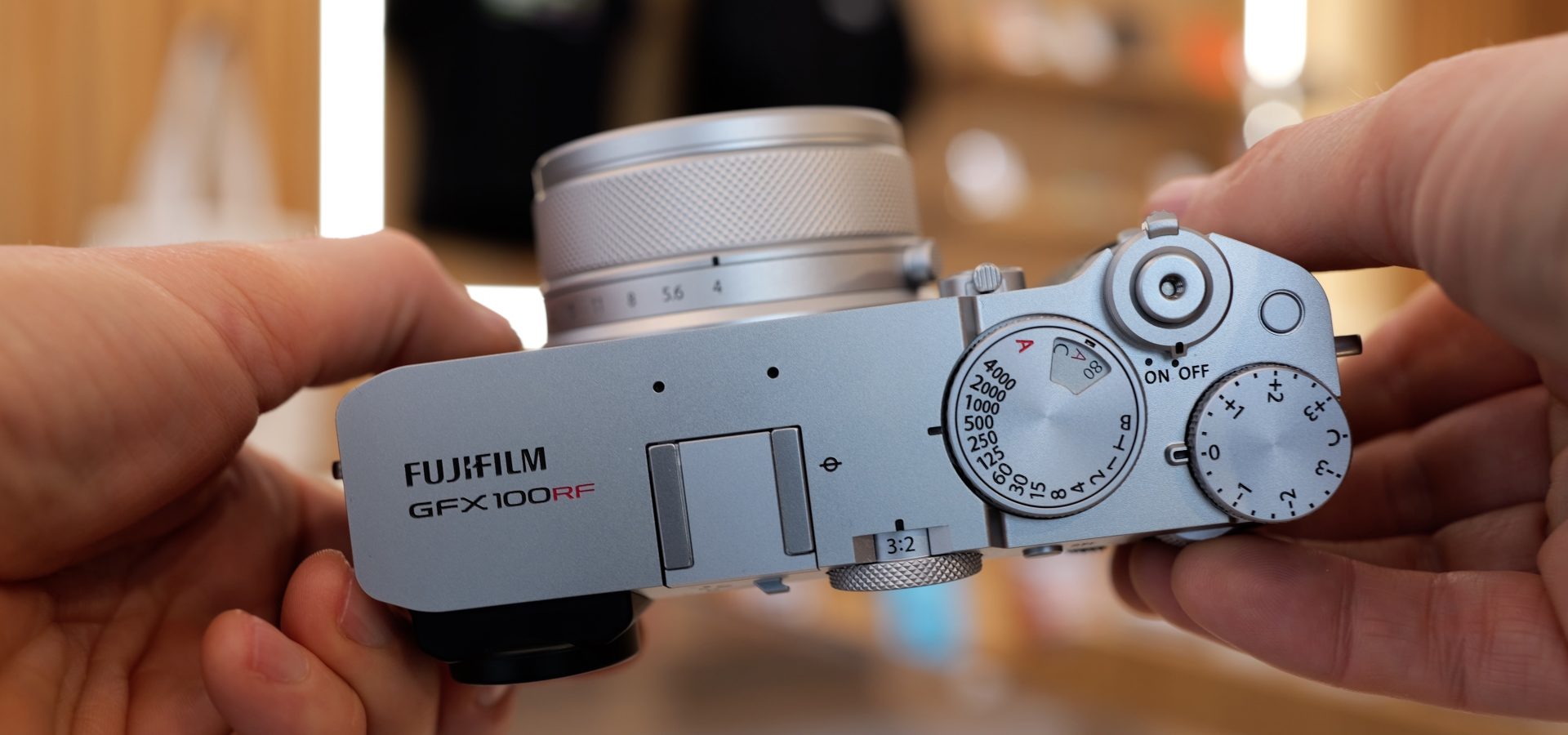
 The Fujifilm GFX100RF is a fixed lens rangefinder-styled camera with a 102 Megapixel medium format sensor. It essentially takes the large sensor, image processor and viewfinder of the GFX100S II and packs them into a smaller and lighter body with a fixed 28mm equivalent lens that’s more akin to a slightly chunkier version of the popular X100 series. Fujifilm says it’s aimed at high-end enthusiasts and serious pros who appreciate the style of a rangefinder camera. I’d say if you loved the X100 but just wished it had a much larger sensor with way higher resolution photos, this is the camera for you. And while it can film respectable video, this is a camera aimed at photography first; how often do we get to say that? Check back soon for my final verdict, but read on for my tests and thoughts so far!
The Fujifilm GFX100RF is a fixed lens rangefinder-styled camera with a 102 Megapixel medium format sensor. It essentially takes the large sensor, image processor and viewfinder of the GFX100S II and packs them into a smaller and lighter body with a fixed 28mm equivalent lens that’s more akin to a slightly chunkier version of the popular X100 series. Fujifilm says it’s aimed at high-end enthusiasts and serious pros who appreciate the style of a rangefinder camera. I’d say if you loved the X100 but just wished it had a much larger sensor with way higher resolution photos, this is the camera for you. And while it can film respectable video, this is a camera aimed at photography first; how often do we get to say that? Check back soon for my final verdict, but read on for my tests and thoughts so far!